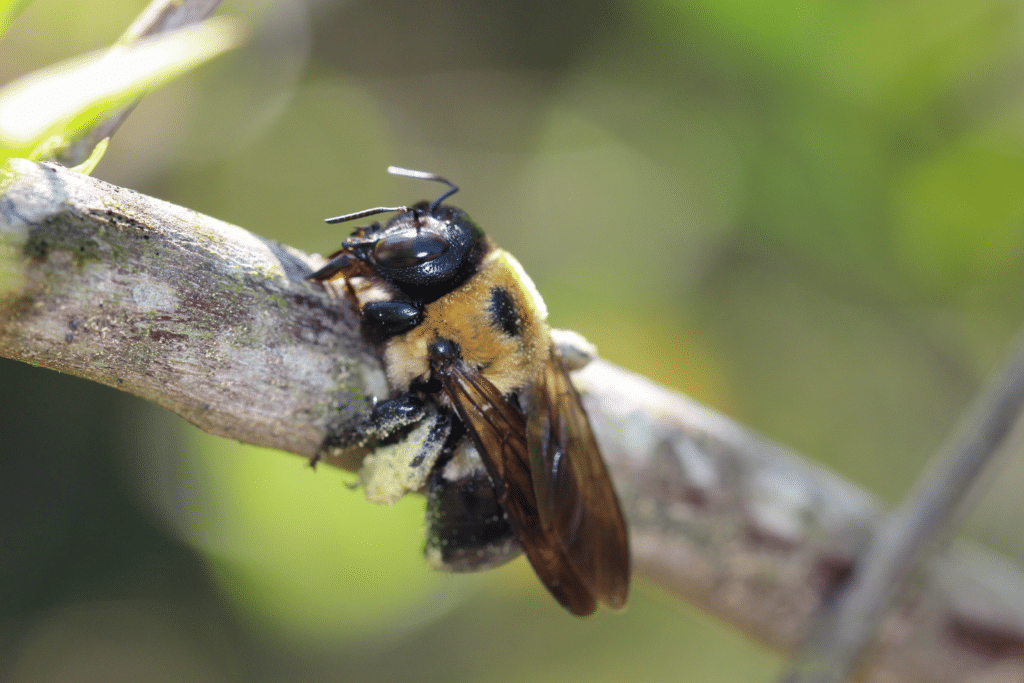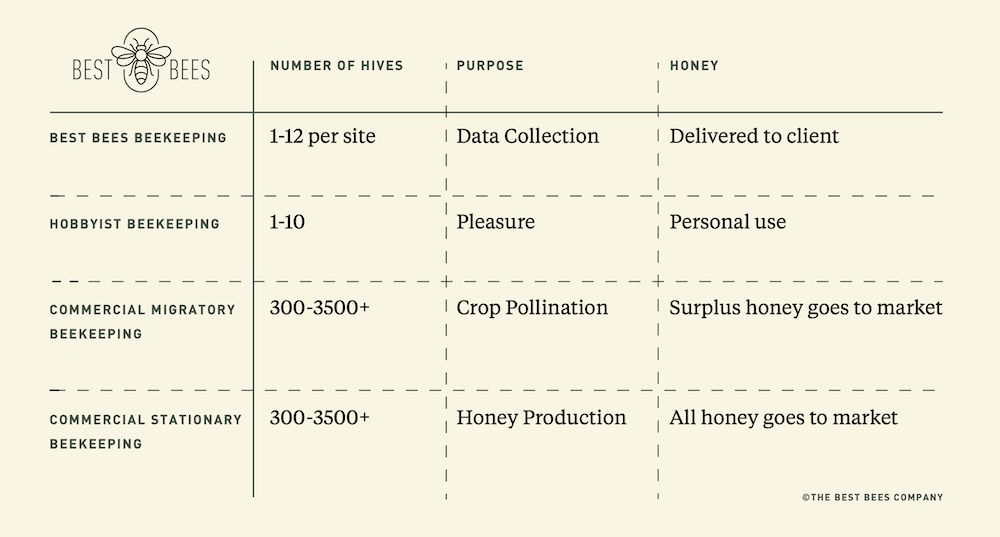Contents:
- What is a carpenter bee?
- Types of carpenter bees
- Carpenter Bee Quick Facts
- Carpenter Bee Biology and Behaviors
- Carpenter Bee Nests
- Male vs. Female Carpenter Bees
- Carpenter bee vs. Bumble Bee: How to identify a carpenter bee
- Carpenter Bee Control, Prevention & Removal
- FAQs
What is a carpenter bee?
The twenty thousand species of bees are classified into nine different families, which can be divided into three broad groups according to the average length of the bee’s tongue, or proboscis. Carpenter bees are classified as long-tongued bees (apidae), and are largely solitary insects.The carpenter bee is the largest native bee in the United States, along with the bumble bee. This bee receives its name from its nesting habits, where they dig and burrow into hard material like wood or even bamboo. Carpenter bees are excellent pollinators for many of the flowering plants in our gardens, on farms, and in natural areas–and according to PennState Extension, 15% of our agricultural crops are pollinated by native bees like the carpenter bee.
Types of carpenter bees
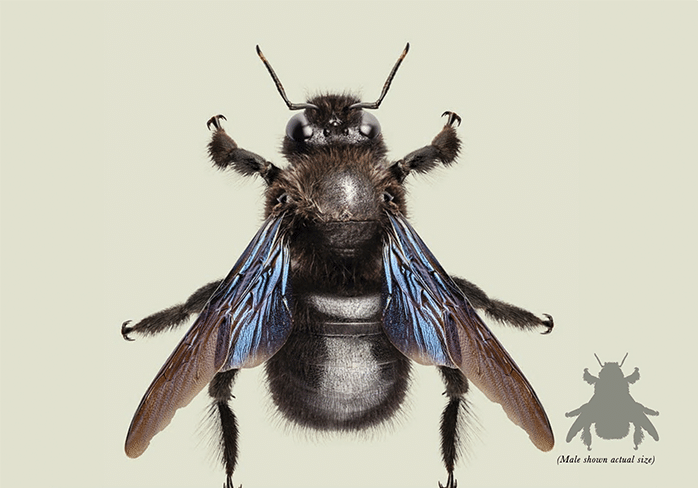
There are hundreds of types of carpenter bee species found all over the world, and each varies in its appearance, location, and overall behavior. For example, the Violet Carpenter Bee is a black bee with dark wings, which in bright light shine purple or blue. This carpenter bee, native to Asia, is active from February to June, raising one and sometimes two broods each year. They nest from April in deadwood, grass stems, or bamboo canes. They also nest in wooden houses and are sometimes regarded as pests (although this bee is not aggressive to humans and rarely stings).
Another type of carpenter bee is the Eastern Carpenter Bee, which can be found in much of the United States and in Canada. According to BestBeeBrothers.com, the Eastern Carpenter bee favors structural timbers for nesting, including pine and cedar wood. The Eastern Carpenter Bee is the most common type of carpenter bee, and what sets it apart is its ability to cut into the sides of flower petals to access the nectar without even pollinating it–this is what gives them the “nectar robber” nickname. This bee species is often known for its jawbones that are designed to make them more efficient nectar collectors than other types of carpenter bees.
The California Carpenter Bee (also known as the Valley Carpenter Bee) is native to western North America and is the largest bee found in California. This carpenter bee makes its nest by creating long, double-ended passages in the limbs of oak trees. OurCityForest.org notes that their nests are typically guarded and cared for by a mother bee and her unmated daughters–and that the male Valley Carpenter Bee is rarely ever seen.
Carpenter Bee Quick Facts
Color: Primarily black with shiny abdomens (not hairy). Males are orange and black, while females are completely black.
Number of Legs: Six
Shape: Oval
Antennae: Yes
Region: All continents except Antarctica. In the United States, carpenter bees are found all throughout the country, although the most common carpenter bee (easter carpenter bee) can be found as far south as Florida and as far north as Maine.
Carpenter Bee Biology and Behaviors
Diet: Carpenter bees feed on nectar from flowers, and while it is dependent on the exact species of bee, carpenter bees visit a wide range of pollen and nectar sources, including fruit trees, hibiscus, blueberries, and even daffodil. There is a common misconception that carpenter bees eat wood, but this material is only chewed through to create their nests.
Lifecycle: Carpenter bees have four life stages (egg, larval, pupal, and adult). According to Orkin.com, this native bee takes seven weeks to reach adulthood, and newly developed adults remain in the nest for several weeks. The average lifespan of the carpenter bee is about one year.
Pollination: Carpenter bees are fantastic pollinators, and they have a unique way of gathering pollen from flowering plants. Buzz pollination, or sonication, is a technique employed by carpenter bees, but also bumble bees, stingless bees, and many others to release pollen grains from certain species of plants. The Best Bees Company Co-Founder Dr. Noah Wilson-Rich notes that these plants have what are known as poricidal anthers, which when vibrated release pollen through small pores; these plants depend on buzz pollination because there is not enough power in the wind or typical bee pollination to extract the pollen. So in order to pollinate these plants, the carpenter bee will grasp the flower with its legs or mouthparts and then rapidly vibrate its flight muscles to free the pollen for harvesting.
Reproduction: The female carpenter bee digs a tunnel into a piece of wood, constructs a ball of bee bread consisting of nectar and pollen, and lays her eggs on top. She then seals the tunnel with sawdust chips and leaves only a small chamber where her eggs are. These eggs are then left with no more than the bee bread provision, and the bees are on their own to dig their way out of the hive once they emerge from their cells. Carpenter bees, similar to other bee species, also have elaborate courtship displays by drones. This means that the drone will engage in intricate displays to woo a mate with private dances.
Carpenter Bee Nests
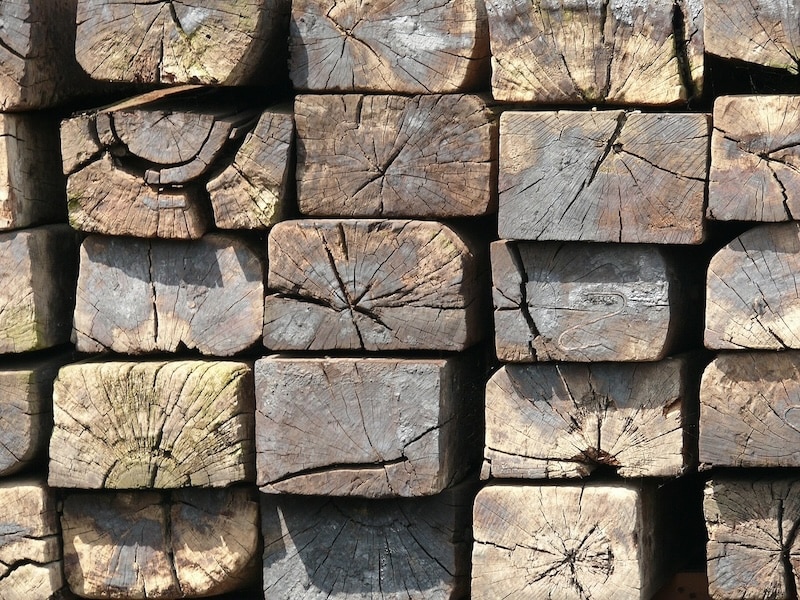
Over 90% of bee species are solitary, and the carpenter bee is a common solitary insect – although sometimes they have been known to nest in small groups! While the honey bee depends on a colony to survive, the carpenter bee can forage, build nests, reproduce, and even defend itself.
To build a nest, the carpenter bee chews perfectly round holes into the wood with its mandibles to create small tunnels for it to fit through. These tunnels are called galleries, and according to BeeHiveHero.com, they can be up to 10 feet long. Similar to the honey bee hive, the nest of a carpenter bee is used for storing food, protection, and for laying eggs.
According to The Bee: A Natural History, written by The Best Bees Company Co-Founder Dr. Noah Wilson-Rich, it’s possible to help these native pollinators create nesting sites, and all it takes are a few materials. By providing wooden logs, boards, or blocks (typically within a house, barn, or shed), carpenter bees are able to bore in and create nests of their own.
Male vs. Female carpenter bees
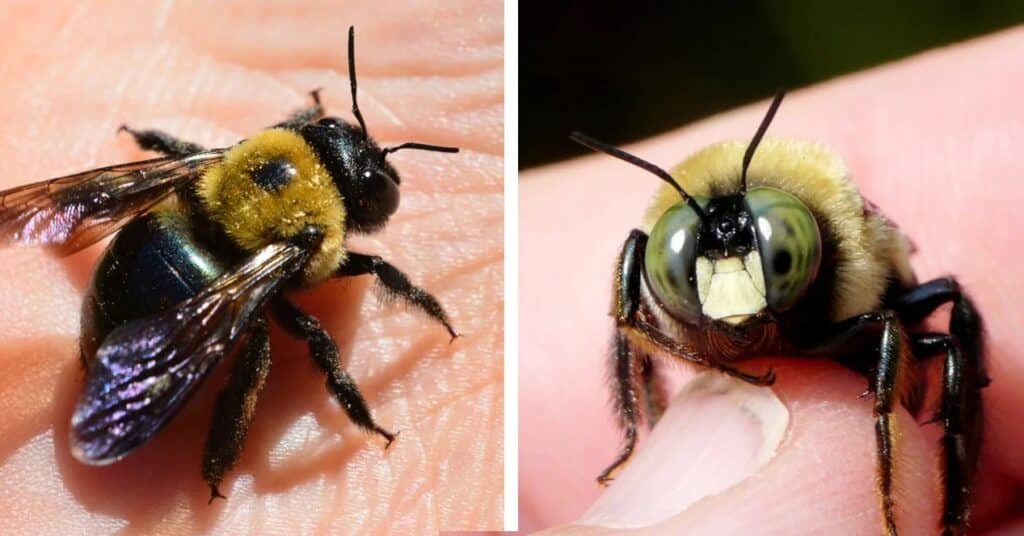
Physically, a male and female carpenter bee look almost the same – but there’s so much more to these bees than meets the eye! One sure-fire way to distinguish between the two is to take a look at their heads: the male will have a white spot, while the female’s head is completely black and unmarked.
Male and female carpenter bees also have very different jobs, too. The sole responsibility of the female carpenter bee is to build nests by drilling and burrowing through wooden holes, while the male carpenter bee is always on the defense: its main job is to protect its nest, and although it does not have a stinger, its larger size and aggressive nature helps it ward off any unwanted visitors. Since the female carpenter bee is often busy building the nest, it’s rare that you would come into contact with one, but if you do, it’s important to know that the sting from a female carpenter bee can be quite painful.
Chart from a-z-animals.com:
| Male Carpenter Bee | Female Carpenter Bee | |
| Head Color | Has a white spot or marking on his head. | Completely black |
| Roles and Responsibility | Defends its territory and nests | Burrows wood and makes holes to build nests |
| Stingers | Has no stingers | Has stingers on her back |
| Temperament | More aggressive | More even-tempered |
| Nectar Robbing | Responsible for most nectar robbing
Mildly destructive to flower structure when compared to females. |
Responsible for less nectar robbing compared to males
Extremely destructive to flower structure |
Carpenter bee vs. Bumble Bee: How to identify a carpenter bee
Carpenters are often mistaken for bumble bees, but there are a few ways that you can tell these two pollinators apart. First, we can compare the two visually” although both are dark and can have orange/yellow color, a carpenter bee’s abdomen is black, bare, and shiny–the abdomen of a bumble bee is very fuzzy with yellow markings.
Another difference between these two bees is their behavior: bumble bees are known as social insects, in which they live with many other bees and depend on each other to survive. On the other hand, a carpenter bee is solitary and doesn’t form a hive (although they sometimes nest in small groups).
As noted above, the male carpenter bee does not have a stinger but it uses its large, buzzing body to protect its territory. Bumble bees have stingers and can use them without ever losing the stinger itself– similar to the female carpenter bee, a bumble bee is not typically aggressive and will only sting if it feels like its colony is threatened.
Carpenter Bee Control, Prevention & Removal
Since carpenter bees prefer wood for their nests, it’s very common to see this species of bees make themselves at home inside wooden structures and can actually weaken the wood over time with their nests. Carpenter bees like weathered, unpainted, and softened wood, so they’re likely found within decks, on outdoor furniture, in sidings, or even in rafters.
According to CrownBees.com, prevention is the best method for managing carpenter bees. By providing homes for carpenter bees, or applying almond/citrus oil in places you do not wish to have these native bees nest, you can prevent this bee from becoming a pest in your yard without harming the pollinator.
FAQs
Q: Do carpenter bees sting?
A: Female carpenter bees can sting and will do so if they feel threatened, but the male carpenter bee does not have a stinger. When stinging, the female carpenter bee releases bee venom and does not lose its stinger.
Q: How do you treat a carpenter bee sting?
A: You can treat a carpenter bee sting similarly to other bee stings: apply a cold compress or ice pack to bring down any inflammation, and if the spot is still painful, over-the-counter medication can help.
Q: Do carpenter bees pollinate?
A: Carpenter bees do pollinate, and they are excellent at doing so. With a process called Buzz Pollination, carpenter bees are able to pollinate plants that need additional help releasing pollen by rapidly vibrating their flight muscles while holding onto the flower.
Q: Do carpenter bees make honey?
A: Although carpenter bees pollinate flowering plants and feed on nectar, they do not produce honey.


